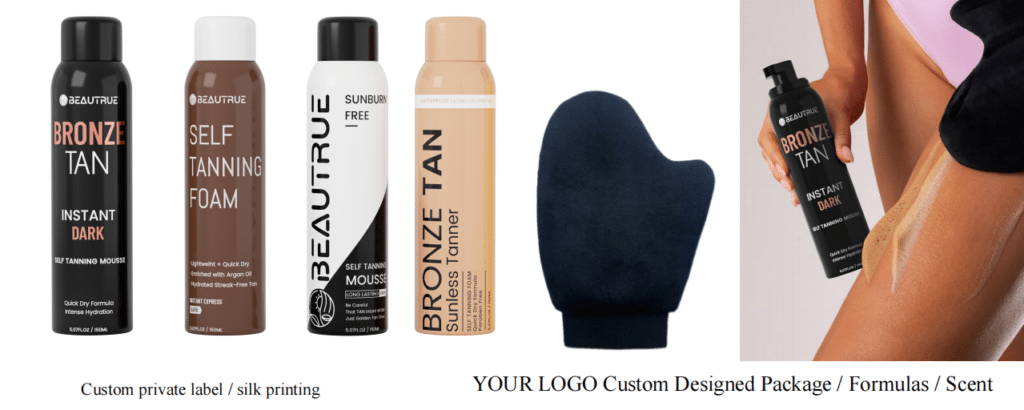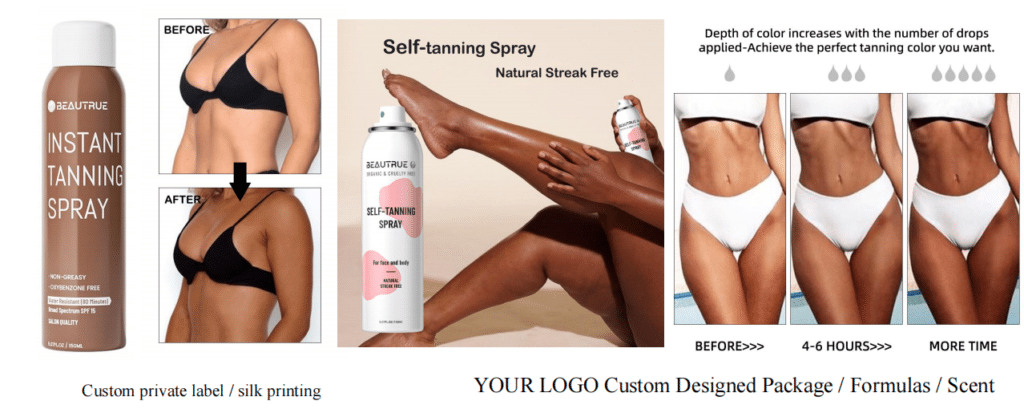
The difference between self tanning mousse and self tanning spray: which one is better? Who is it suitable for?
In recent years, the popularity of tanning products in the global beauty market has continued to rise, especially in Europe, America, Australia and other regions, where healthy bronze skin has become a trend. Whether it is a tanning enthusiast or a consumer who wants to achieve skin color changes in a safer way, tanning mousse (Tanning Mousse) and tanning spray (Tanning Spray) have become their first choice products.
However, many consumers (and even beauty brands) still have questions about the difference between these two tanning products, the applicable population and market trends. As a professional B2B tanning product manufacturer, we hope to use this article to analyze the differences between tanning mousse and tanning spray in detail for everyone, and help brand decision makers choose more suitable products for OEM and sales.
1. Why do people want to use tanning products?
Shape a healthy image
In European and American culture, bronze skin is often regarded as a symbol of health, vitality and sportiness. Especially in summer, the skin appears tighter and more three-dimensional after tanning.
Alternative to sun exposure, avoid skin damage
Long-term sun exposure may cause skin aging and even increase the risk of skin cancer, while tanning spray and mousse are a safe alternative that can quickly change color without UV radiation.
Satisfy personalized beauty needs
Consumers of different skin colors hope to adjust their skin color through tanning products to achieve different degrees of “bronze” or “caramel” to highlight their personal style.
The driving role of social media
Bloggers and beauty experts on platforms such as Instagram and TikTok frequently recommend the use of tanning products, triggering a widespread follow-up effect.

2. The history of tanning mousse and spray tan: from tanning oil to modern tanning technology
Mid-20th century: The rise of tanning culture
After Coco Chanel’s tanning photos became a fashion icon in the 1920s, tanning gradually became a mainstream trend. At first, people achieved tanning effects by sunbathing on the beach.
1960s-1970s: The birth of spray products
The first generation of self-service spray tanning products was launched, but due to technical limitations, the color was unnatural and easy to be mottled.
2000s: Breakthrough in mousse texture
Tanning mousse quickly became the mainstream in the market with its advantages such as light feel, quick drying, and easy control of coloring range.
In recent years: Intelligent formula and skin-beautifying ingredients added
The new generation of tanning products is no longer just dyeing, but combines skin care effects, such as adding hyaluronic acid, vitamin E, and natural plant extracts to improve skin feel and durability.
3. The main differences between tanning mousse and tanning spray
1) Different ways of use
Tanning mousse: usually applied with tanning gloves, with a light and foamy texture, easy to spread evenly, suitable for novices or people who want to accurately control coloring.
Tanning spray: used like spray perfume, can be sprayed on the back, legs and other hard-to-reach areas, quickly coloring, but easy to spray unevenly.
2) Color saturation and durability
Tanning mousse is generally more saturated in color and lasts longer.
Spray is suitable for temporary use, such as weekend parties or short trips.
3.)Makeup application time and drying speed
Mousse dries faster, but you still need to wait to get dressed.
Stand still for a few minutes after using the spray to avoid color transfer.
4) Is it easy to leave color difference?
Mousse is less likely to leave color difference due to its strong controllability.
If the spray is not used properly, “mottled” or “spray shadows” may appear.
4. Which is better, tanning mousse or tanning spray?
There is no absolute answer to this question. The key lies in user needs and brand positioning.
If your target customers are users who pursue high quality and have rich experience in self-care, then tanning mousse is more popular.
If your customers are mainly students, first-time tanning users or fast-paced users, tanning spray is more attractive because of its convenience.
You can also launch “combination products”, such as spray + correction brush, mousse + color fixer, to increase user stickiness.
5. Which groups prefer tanning mousse and tanning spray?
Female users (18-35 years old) are the main consumer group, especially in Europe, America and Australia.
Male users are also growing rapidly, especially those who like fitness, modeling or performing arts.
Beauty experts, fitness enthusiasts, stage performers and other scene users who need to change skin color quickly prefer spray products.
Salons and beauty salons will also purchase large bottles of spray for in-store services.
6. What are the mainstream tanning mousse and tanning spray brands in the market?
The leading products in the European and American markets include:
St. Tropez (UK)
High-end positioning, mousse products are particularly outstanding.
Bondi Sands(Australia)
Has a rich product line, from mousse to spray.
Isle of Paradise
Mainly natural ingredients, suitable for sensitive skin, the spray has a natural tone.
Loving Tan
Professional level, suitable for experienced users, darker color.
MineTan, Tanologist, Fake Bake, etc. also have a stable market share on e-commerce platforms.
7. How to choose the right type of tanning product according to customer needs?
As a brand or retailer, it is recommended to combine the following analysis:
Frequency of use and experience value of target users
Product positioning: high-end or mass?
Do you need to see results quickly? Do you emphasize skin care effects?
Consumer habits and regulatory requirements of the country’s market
Does the product need labels such as halal, vegetarian, and cruelty-free?
8.Market trends and sales of global tanning products
According to data from market research institutions such as Statista and Mintel:
The global self-tanning product market will be worth approximately US$1.5 billion in 2023 and is expected to grow to US$2.3 billion by 2028.
Europe and the Americas are the main consumer bases, while emerging markets in the Middle East and Asia are growing rapidly.
Tanning mousse has performed strongly in professional and retail channels.
Spray products have seen a surge in sales on online platforms, especially the “Instant Spray” series.
9. OEM opportunities we see from tanning product data
As a B2B manufacturer focusing on beauty and personal care, we serve multiple international brands and draw the following conclusions from market data:
Brands need differentiation: Consumers are no longer satisfied with basic tanning and want functions such as “tanning + skin care” and “adjustable tanning”.
Small batches and fast ordering: More and more new brands want to test the market and need flexible production line support.
Customized fragrance, skin feel, and color levels have become popular OEM requests.
Environmentally friendly and sustainable packaging is also one of the brand appeals.
10. Conclusion: Why choose us as your tanning product OEM partner?
We have internationally certified production workshops and support European and American regulatory standards.
We provide one-stop OEM/ODM services from formulation, filling, packaging design to compliance testing.
We support customized tanning mousse, spray, dropper liquid, color fixer, color remover foam and other categories.
We can develop halal, vegan, alcohol-free, hypoallergenic and other formulas according to different market needs.
Provide professional product knowledge training and marketing suggestions to help brands go online quickly.
📞 Welcome to contact us to get samples and quotes, and start your exclusive tanning brand journey!
